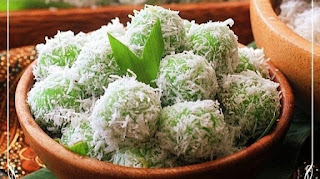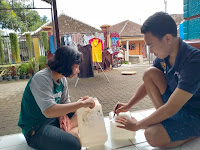Text procedure Rico Bayu Fanreza
How to Make Klepon :
a sweet Indonesian snack
If you are on the island of Java, Indonesia, this local sweet snack is called klepon, ondeh-ondeh if you’re in Singapore, Malaysia and parts of Sumatra. The difference in name is testament to how well-loved (and travelled) klepon is. From Java, where klepon originates, this treat spread across the Malay Archipelago and even inspired a folk song entitled 'Jaja Klepon'.
But this humble snack's journey did not stop there. It was adapted by the *Peranakan community and ended up in the Netherlands by way of Indonesian immigrants who moved West in the 1950s, where it is sold today in Asian restaurants and supermarkets thousands of kilometres from its birthplace.
Klepon is?
Klepon is a small, boiled glutinous cake, filled with liquid coconut sugar (gula jawa) and covered in grated coconut. It packs a sweet punch in your mouth when you bite into it. Sound delicious? Klepon is traditionally coloured green with a paste made from the leaf of pandan or the dracaena plant (daun suji) — whose leaves are used widely in Southeast Asian cooking.
If you've been following our 'a journey bespoke' travels, (it's been four exciting years now), Jo and I have tasted our way around many Indonesian cake shops, savouring the incredible variety of delicious sweet treats on offer. We thought it was about time we paid homage to klepon.
Our klepon recipe is a lot of fun to make, particularly if you decide to make the green food colouring yourself. I recently discovered, tucked away and growing against my front fence was the wonder- plant of food colouring 'daun suji.' which then became another good reason to make klepon.
Read on for our recipe, and everything you need to know to make a batch for yourself!
Klepon
(Glutinous rice balls with coconut sugar and coconut)
Makes :
Ingredients
250g glutinous rice flour
50 g rice flour
50ml water
100g gula jawa (coconut sugar)
100g fresh daun suji or half daun suji and half pandan leaves (an alternative to daun suji and pandan is 2-3 drops green food colouring or pandan paste)
1 coconut, fleshly grated (if you live in Jakarta, local vendors in the traditional pasars sell fresh coconuts and have simple machinery to grate them for you)
Pinch of salt
2 litres of water for boiling
Method
Step 1 : Have some fun and make natural green food colouring or suji water!
Cut suji leaves into thin strips and place into a blender. Pour in water and blend until fine. Next, use a strainer and squeeze out the water. Note that the suji leaf fibres will not dissipate so the thinner the leaves are cut, the better. The resulting liquid will be a dull jade-green.
From my garden : a branch of Dracaena angustifolia or Pleomele angustifolia. In Indonesia, the Dracaena is called Suji and the leaves make an excellent food colouring. Suji leaves give a natural green colour to foods but they don’t have a sweet fragrant aroma like pandan. The green colour of suji is darker than that of pandan leaves, which make them the perfect choice for klepon.
Daun Suji (suji leaves) pulled from the branch above and ready to be thoroughly washed and trimmed
Cut the suji leaves into thin strips and place into a blender
Pour in enough water to blend easily, pulse in a blender until fine
Using a spoon, pass the blended suji through a sieve and watch as the green liquid colouring appears
The resulting liquid extract has a very short shelf life, best to use immediately or store in the fridge for 2 to 3 days
Step 2 : Mix the suji water with glutinous rice flour
Add the suji juice into a bowl containing the glutinous rice flour. Once the mixture starts to come together, knead it lightly until smooth. The texture should be similar to bread dough. If the flour is still too hard, add extra suji juice by the tablespoon. Once done, form into the shape of a ball, cover and leave to rest as you prepare the next steps.
Add the suji juice into a bowl containing the glutinous rice flour
Form the dough into the shape of a ball, cover and leave to rest as you prepare the next steps
Step 3 : Prepare the gula jawa
Place the gula jawa on a chopping board and coarsely chop.
Chopped gula jawa
Step 4 : Prepare grated coconut
Place the grated coconut on a dish and steam over a pot of boiling water for 20 minutes or microwave on high heat for one minute. This steams the coconut to cook it. Once done, sprinkle salt and stir till well-mixed. The grated coconut acts as a mildly savoury element to counter the sweetness of the centre.
Fresh coconut ready to be steamed. A couple of days a go I visited Pasar Mede on Jl. Fatmawati. The coconut vendor freshly grated this coconut for me. The remaining half of the grated coconut I've stored in the freezer.
Step 5 : Form the balls
Return to the dough mix. Separate enough dough to form 5 cm round balls. Roll them into a sphere and make an indentation to place the gula java shards. Once in place, roll into a complete ball, making sure that no part of the gula java is exposed or it will seep out during cooking. Note that each ball should ideally be bite-sized as the klepons’s molten centre will ooze out if it requires two bites.
Separate enough dough to form 5 cm round balls
Roll them into a sphere and make an indentation to place the gula java shards
Dough balls filled with gula jawa ready to be steamed
Step 6 : Cook
Bring water in a deep pan to a boil. Lower the balls in slowly, one at a time, and leave them in the rolling boil. Be sure to stir to stop the balls from sticking to the bottom of the pan. The klepon is ready once they float to the surface. This will take approximately 3-4 minutes.
Lower the balls in slowly, one at a time, and leave them in the rolling boil
Remove the klepon from the water with a slotted spoon
To serve
Once cooked, remove them from the water with a slotted spoon and roll each ball in grated coconut. When you bite into them, there is a nice surprise when the melted palm sugar inside, pops in your mouth!
Klepon, the perfect afternoon sweet snack
Cooks notes:
The gula jawa inside the dough is extremely hot, so wait for it to cool slightly before eating to avoid burning your tongue
Klepon are best served on the same day as the dough will harden. If you have leftover you can store them in the fridge, and warm them a little in the microwave
Klepon freeze well




















Komentar
Posting Komentar